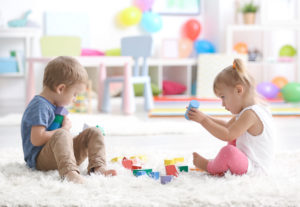Fostering Imagination Through Small World Play
 Have you ever watched a child pick up a random object and be amazed with what they thought to do with it? Maybe they took a tissue from the box and created a cape for a doll, or found a few wood chips and made a family out of them. As we get older, we sometimes lose the ability to see things in new ways. We are trained to get jobs done and oftentimes, even in our own “playtime,” get stuck on rules or etiquette. We need to know the “right” way to play. There are, of course, certain times where rules must be enforced, but children also need an outlet for creativity.
Have you ever watched a child pick up a random object and be amazed with what they thought to do with it? Maybe they took a tissue from the box and created a cape for a doll, or found a few wood chips and made a family out of them. As we get older, we sometimes lose the ability to see things in new ways. We are trained to get jobs done and oftentimes, even in our own “playtime,” get stuck on rules or etiquette. We need to know the “right” way to play. There are, of course, certain times where rules must be enforced, but children also need an outlet for creativity.
You can help foster your child’s imagination, no matter how old they are, by encouraging and creating opportunities for small world play. Small world play refers to play with small toys and everyday objects, and allows children to create their own fantasy worlds in a familiar environment.
Small world play has many, many benefits: Children develop socially through play; they can learn others’ perspectives on how to play with the materials, as well as respect and boundaries. Children develop emotionally through imaginative play, even playing by themselves; through the creation of different characters, children have outlets to express themselves in multiple ways. Small world play also yields physical and intellectual benefits. Children practice their motor skills by manipulating the objects during play. Depending on the materials, they can also learn about patterns, numbers, and even physics – think of differently shaped building blocks toppling over without the correct support!
So, how can you set up or encourage small world play? Look around your home! You can create themes or just have a hodgepodge of items. You can create a terrarium with a shoebox or storage container, a handful of dirt and stones, maybe some leaves or sticks, rope or yarn. If you don’t have the “right” animal toys for a terrarium, that’s okay! Children will get creative with whatever materials you provide. Toss in an action figure or toy car, and see what stories your child can come up with for why they might be there.
For more information and resources on engaging young children at home, check out the National Association for the Education of Young Children’s website, then get to playing!
